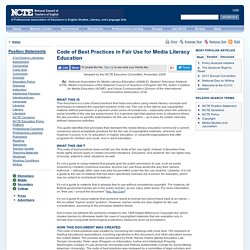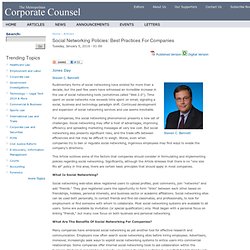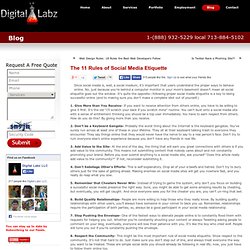

Code of Best Practices in Fair Use for Media Literacy Education. Adopted by the NCTE Executive Committee, November 2008 By: National Association for Media Literacy Education (NAMLE), Student Television Network (STN), Media Commission of the National Council of Teachers of English (NCTE), Action Coalition for Media Education (ACME), and Visual Communication Division of the International Communication Association (ICA) WHAT THIS ISThis document is a code of best practices that helps educators using media literacy concepts and techniques to interpret the copyright doctrine of fair use.

Fair use is the right to use copyrighted material without permission or payment under some circumstances -- especially when the cultural or social benefits of the use are predominant. It is a general right that applies even in situations where the law provides no specific authorization for the use in question -- as it does for certain narrowly defined classroom activities. Social Networking Policies: Best Practices For Companies. Rudimentary forms of social networking have existed for more than a decade, but the past few years have witnessed an incredible increase in the use of social networking tools (sometimes called "Web 2.0").

Time spent on social networks now exceeds time spent on email, signaling a social, business and technology paradigm shift. Continued development and expansion of social networking services and use seems inevitable. For companies, the social networking phenomenon presents a new set of challenges. Social networking may offer a host of advantages, improving efficiency and spreading marketing messages at very low cost. But social networking also presents significant risks, and the trade-offs between efficiencies and risk may be difficult to weigh. Policy Priorities:Can Social Media and School Policies be "Friends"?:Can Social Media and School Policies be "Friends"? Winter 2011 | Volume 17 | Number 4 Can Social Media and School Policies be "Friends"?

Between 2004 and 2009, the amount of time that kids ages 2 to 11 spent online increased by 63 percent, according to a Nielsen study. Driving these trends is increasing mobile access, which research from International Data Corp. predicts will eclipse wired access to the Internet by 2015. The 11 Rules of Social Media Etiquette. Since social media is, well, a social medium, it’s important that users understand the proper ways to behave online.

No, just because you’re behind a computer monitor in your mom’s basement doesn’t mean all social etiquette goes out the window. It’s quite the opposite—following proper social media etiquette is a key to being successful online (and to making sure you don’t make a complete idiot out of yourself.) 1. Give More than You Receive- If you want to receive attention from others online, you have to be willing to give it first. It’s the old “I’ll scratch your back if you scratch mine” routine. 2. 3. 4. 5. Why Social Media Curriculum is Critical in Schools - 140 Charact. I am presenting at The 140 Characters Conference in New York City on April 20th.

This event is the largest worldwide gathering of people interested in the effects of the real-time Internet on business, education, and “we” the people. Some of the other speakers include Ann Curry, NBC News (@AnnCurry), Chris Lehmann, Principal of the Science Leadership Academy, (@chrislehmann), Donny Deustch (@Donny_Deutsch), Ivanka Trump (@IvankaTrump), and MC Hammer (@MCHammer). I will be a part of the Twitter and Education panel and joined by @mbteach, @kjarret, @shellterrell with @parentella moderating. Teaching Kids to Manage their Digital Footprint - 140 Character. Digiteen - Digital Etiquette. 1 .

Overview Digital etiquette, or netiquette as its sometimes called, is a basic set of rules you should follow in order to make the internet better for others, and better for you. It’s just as important to treat people with courtesy and respect online as it is in real life. When you instant message, chat, or email someone over the Internet, they can’t see your face to tell if you’re teasing them or saying something in jest. How do you practice good Netiquette? 2. The internet can be a powerful tool when it comes to circulating opinion or information. 3.
Techdirt did a study that showed that many people purposely responded to emails late at work, because replying to quickly implies that they do not have enough work to do. IM and SMS messages are most subject to misinterpretation, but other communications are less obscure. This are the results from a serve been asked to 10 teenagers. 4. Netiquette The following information came from tech.blorge.com. 1. How Social Media Has Changed Us. Mike Laurie works at London agency Made by Many where he helps design social digital stuff.

You follow him on Twitter @mikelaurie. Over the last 10 years, we've seen social media galvanize thousands over politics, create as many industries as it has destroyed, and offer an abundance of visual and audio entertainment. But has all this incredible change actually changed us, or just the world we live in? Below are some areas in which social media has had lasting, and arguably permanent effects on the ways in which we live. The question is, are these changes all for the better? Child Literacy It stands to reason that children who read and write more are better at reading and writing. Ambient Intimacy Lisa Reichelt, a user experience consultant in London coined the very pleasant term "ambient intimacy. " Consider the many communications technologies through history — the telephone, Morse code, semaphore, carrier pigeons, smoke signals — they are all fairly inconvenient and labor intensive.
14 Ways K–12 Librarians Can Teach Social Media by Joyce Valenza.